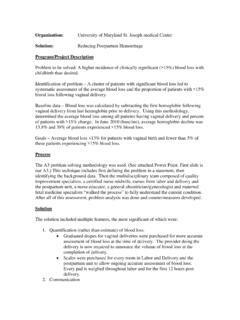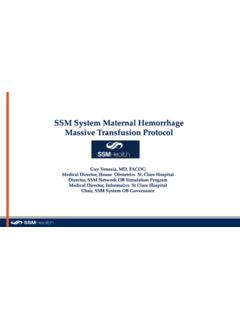Transcription of Maternal Safety Bundles for Obstetric Hemorrhage
1 Maternal Safety Bundles forObstetric HemorrhagePerinatal/Neonatal Learning Network ReunionTurf Valley Conference CenterEllicott City, MDDecember 4, 2014 Dena Goffman, MDEveryone s Mortality and Severe MorbidityApproximate distributions, compiled from multiple studiesCauseMortality(1-2 per 10,000)ICU Admit(1-2 per 1,000)Severe Morbid(1-2 per100)VTE and AFE15%5%2%Infection10%5%5%Hemorrhage15%3 0%45%Preeclampsia15%30%30%Cardiac Disease25%20%10% Maternal Mortality and Severe MorbidityApproximate distributions, compiled from multiple studiesCauseMortality(1-2 per 10,000)ICU Admit(1-2 per 1,000)Severe Morbid(1-2 per100)VTE and AFE15%5%2%Infection10%5%5%Hemorrhage15%3 0%45%Preeclampsia15%30%30%Cardiac Disease25%20%10% Maternal Mortality and Severe MorbidityApproximate distributions, compiled from multiple studiesCauseMortality(1-2 per 10,000)ICU Admit(1-2 per 1,000)Severe Morbidity(1-2 per100)VTE and AFE15%5%2%Infection10%5%5%Hemorrhage15%3 0%45%Preeclampsia15%30%30%Cardiac Disease25%20%10% Hemorrhage Perspective Obstetric Hemorrhage affects 2-5% of all births in the United States and is one of the top causes of Maternal death (Callaghan et al, 2010; Berg et al, (2010); Bingham & Jones, 2012) Nationwide, blood transfusions increased 92% during delivery hospitalizations between 1997 and 2005.
2 (Kuklinaet al, 2009) Failure to recognize excessive blood loss during childbirth is a leading cause of Maternal morbidity and mortality. (The Joint Commission, 2010) Women die from Obstetric Hemorrhage because of a lack of early and effective interventions. (Berg et al. 2005; Della Torre et al. 2011) California Pregnancy Associated Mortality Reviews Missed triggers/risk factors: abnormal vital signs, pain,altered mental status/lack of planning for at risk patients Underutilization of key medications and treatments Difficulties getting physician to the bedside Location of care issues involving Postpartum, ED and PACU University of Illinois Regional Perinatal Network-Failure to identify high-risk status-Incomplete or inappropriate managementDominance of Provider QI Opportunities: Hemorrhage and PreeclampsiaCDPH/CMQCC/PHI. The California Pregnancy-Associated Mortality Review (CA-PAMR): Report from 2002 and 2003 Maternal Death Reviews.
3 2011 (available at: )Geller SE etal. The continuum of Maternal morbidity and mortality: Factors associated with severity. Am J ObstetGynecol2004; 191: in >95% of casesPresent in >90% of casesAddressing the ProblemDevelopment of Patient Safety BundlesNational & NYS efforts ACOG-CDC Maternal Mortality/Severe Morbidity Action Meeting occurred in Atlanta -November 2012 Participants identified key priorities: 6 multidisciplinary working groups were formedBackground -Building ConsensusCore Patient Safety BundlesObstetric HemorrhageSevere Hypertension in PregnancyVenous Thromboembolism Prevention in PregnancySupplemental Patient Safety BundlesMaternal Early Warning CriteriaFacility ReviewFamily and Staff SupportWas comprised of the following individuals with representation from obstetrics , nursing, blood banks, and anesthesia: Debra Bingham, DrPH, RN Washington, DC (AWHONN) Dena Goffman, MD, FACOG New York, NY (ACOG) Jed Gorlin, MD Minneapolis, MN (AABB) Gary Hankins, MD, FACOG Galveston, TX (SMFM) David Lagrew, MD, FACOG Long Beach, CA (CMQCC) Lisa Kane Low, PhD, CNM Ann Arbor, MI (ACNM) Elliott Main, MD (Chair) San Francisco, CA (ACOG) Barbara Scavone, MD Chicago, IL (SOAP)OB Hemorrhage bundle Workgroup123(5):973-977, May 2014 Maternal SafetyObstetricians(ACOG/SMFM/ACOOG)Nurs es(AWHONN)Family Practice(AAFP)Midwives(ACNM)Hospitals(AH A, VHA)OB Anesthesia(SOAP)Birthing Centers(AABC) Safety ,Credentials(TJC)Bloo d Banks(AABC)Perinatal Quality Collaboratives(many)Federal(MCH-B, CDC,CMS/CMMI)State(AMCHP, ASTHO,MCH)Direct ProvidersNurse Practitioners(NPWH)12 Council on Patient Safety : July 2013 Endorsed the concept.
4 3 Maternal Safety Bundles What every birthing facility in the US should Safety bundle details were endorsed by the Council in July 2014 Goals: OB Hemorrhage Patient Safety bundle Improve readinessto Hemorrhage by identifying standardized protocols (general and massive) Improve recognitionof OB Hemorrhage by performing on-going objective quantification of actual blood loss Improve responseto Hemorrhage by utilizing unit-standard, stage-based, Obstetric Hemorrhage emergency management plans with checklists Improve reporting/systems learning of OB Hemorrhage by performing regular on-site multi-professional Hemorrhage drillsHemorrhage cart Immediately available on L&D, antepartum/postpartum Multidisciplinary input for development, stocking and maintenance Containing supplies, checklist, and instruction cards for intrauterine balloons and compressions stitchesReadiness -Every UnitACOG District II Safe Motherhood Initiative (SMI)
5 Readiness -Every UnitImmediate access to Hemorrhage medications Kit or equivalent Considerations include safe storage, error reduction Multidisciplinary solution Assess time to bedside in drillsSurgical Management Uterine curettage Placental bed suture Uterine artery ligation Uteroovarianligation Repair uterine rupture B-Lynch suture, multiple square sutures HysterectomyImages used with permission from:FEMALE PELVIC SURGERY VIDEO ATLAS SERIES Mickey Karam, Series EditorManagement of Acute Obstetric Emergencies BahaSibai, MD [Copyright 2011 by Saunders]B-Lynch sutureB-Lynch sutureHayman uterine compression sutureSurgical ligation locations of uterine blood supplyReadiness -Every UnitEstablish a response team Who/how to call when help is needed Anesthesiology, blood bank, pharmacy, advanced gynecologic surgery, additional nursing resources, CCM, IR, main OR, social services, chaplainHemorrhage Response TeamDrills and education for teams are Care support GynOncology, Maternal -Fetal Medicine, General Ob-Gyn, Critical Care, General Surgery, Urology, Vascular, support (2nd / 3rd person) support (additional staff) ( blood bank and laboratory staff, logistical support)
6 Readiness -Every UnitProtocols for Emergency Release ofBlood Products and Massive Transfusion Emergency release of either universally compatible or type specific red blood cells MTP facilitates rapid dispensing of RBC, FFP and platelets in a predefined ratioReadiness -Every UnitProtocols for Emergency Release ofBlood Products and Massive Transfusion Emergency release of either universally compatible or type specific red blood cells MTP facilitates rapid dispensing of RBC, FFP and platelets in a predefined ratioBlood Bank: Massive Transfusion order to provide safe Obstetric care institutions must: Have a functioning Massive Transfusion Protocol (MTP) Have a functioning Emergency Release Protocol (a minimum of 4 units of O-negative/uncrossmatchedPRBCs) Have the ability to obtain 6 units PRBCs and 4 units FFP (compatible or type specific) for a bleeding patient Have a mechanism in place to obtain platelets and additional products in a timely fashionBlood Bank: Massive Transfusion ProtocolImportant protocol items to be determined at each institution to activate bank number & location; notify as soon as release protocol that both blood bank staff and ordering parties (MD/RN/CNM) will blood be brought to L&D?
7 Will additional blood products/platelets be obtained? for obtaining serial labs, such as with each transfusion pack, to ensure transfusion targets achievedReadiness -Every UnitUnit education on protocols, regular unit-based drills with debriefs Familiarize all team members with entire Safety bundle and new management plan Identification of correctable systems issues Practice team related skillsRecognition and Prevention -Every PatientAssessment of Hemorrhage risk Antepartum, on admission to Labor and Delivery, later in labor, on transfer to postpartum care Allows for anticipatory planning Multiple tools availableLyndon A, LagrewD, Shields L, MelsopK, Bingham B, Main E (Eds). Improving Health Care Response to Obstetric Hemorrhage . (California Maternal Quality Care Collaborative Toolkit to Transform Maternity Care) Developed under contract #08-85012 with the California Department of Public Health; Maternal , Child and Adolescent Health Division; Published by the California Maternal Quality Care Collaborative, July and Prevention -Every PatientMeasurement of cumulative blood loss Formal, accurate measurement (QBL) Calibrated drapes/canisters Weighing blood soaked items and clots Cumulative record throughoutRecognition and Prevention -Every PatientActive management of the 3rd stage of labor Departmental protocol for routine oxytocin use in the immediate postpartum periodPicture from: A, LagrewD, Shields L, MelsopK, Bingham B, Main E (Eds).
8 Improving Health Care Response to Obstetric Hemorrhage . (California Maternal Quality Care Collaborative Toolkit to Transform Maternity Care) Developed under contract #08-85012 with the California Department of Public Health; Maternal , Child and Adolescent Health Division; Published by the California Maternal Quality Care Collaborative, July -Every HemorrhageUnit-standard, stage-based, obstetricHemorrhage emergency management plan Triggering events Response team and roles Communication plan for activation Necessary medications/equipment and tools Multidisciplinary design Drills/debriefs/reviewsLyndon A, LagrewD, Shields L, MelsopK, Bingham B, Main E (Eds). Improving Health Care Response to Obstetric Hemorrhage . (California Maternal Quality Care Collaborative Toolkit to Transform Maternity Care) Developed under contract #08-85012 with the California Department of Public Health; Maternal , Child and Adolescent Health Division; Published by the California Maternal Quality Care Collaborative, July District II Safe Motherhood Initiative (SMI) Obstetric HemorrhageSimulation and Drill InformationResponse -Every HemorrhageSupport program for patients, families,and staff for all significant hemorrhages Traumatic for all Resources availableLyndon A, LagrewD, Shields L, MelsopK, Bingham B, Main E (Eds).
9 Improving Health Care Response to Obstetric Hemorrhage . (California Maternal Quality Care Collaborative Toolkit to Transform Maternity Care) Developed under contract #08-85012 with the California Department of Public Health; Maternal , Child and Adolescent Health Division; Published by the California Maternal Quality Care Collaborative, July District II Safe Motherhood Initiative (SMI) Learning -Every UnitEstablish a culture of huddles and debriefs to identify successes and opportunitiesfor improvement Briefs, huddles and debriefs become part of the routine Will improve role clarity, situational awareness and utilization of available resourcesLyndon A, LagrewD, Shields L, MelsopK, Bingham B, Main E (Eds). Improving Health Care Response to Obstetric Hemorrhage . (California Maternal Quality Care Collaborative Toolkit to Transform Maternity Care) Developed under contract #08-85012 with the California Department of Public Health; Maternal , Child and Adolescent Health Division.
10 Published by the California Maternal Quality Care Collaborative, July Learning -Every UnitMultidisciplinary review of serious hemorrhages for systems issues Formal meetings to identify any systems issues or breakdowns that influenced the outcome of the event Multidisciplinary Perinatal Quality Committee Sanctioned and Learning -Every UnitMonitor outcomes and process metricsin perinatal quality improvement (QI)committee Process measures used to document the frequency that a new approach is used Outcome measures used to determine project success Goal: reduce the number of hemorrhages that result in severe Maternal morbidity or mortality Follow internally 4 or more units of RBC and require ICU careThings to Remember Early opportunities exist to assess risk, anticipate, and plan in advance of an Obstetric Hemorrhage . Development of a multidisciplinary taskforce with physician and nursing champions from OB, anesthesia, and blood bank is critical.


















